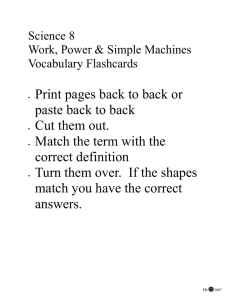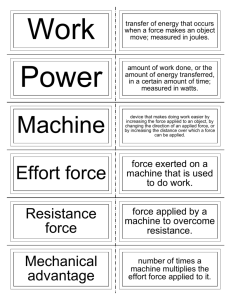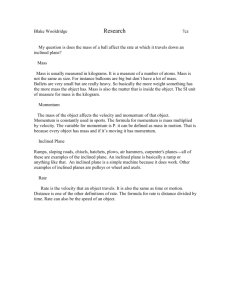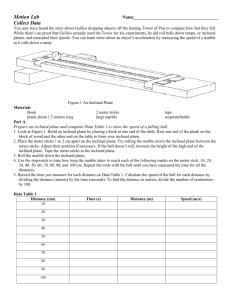Simple Machines - Ontario Science Centre
advertisement
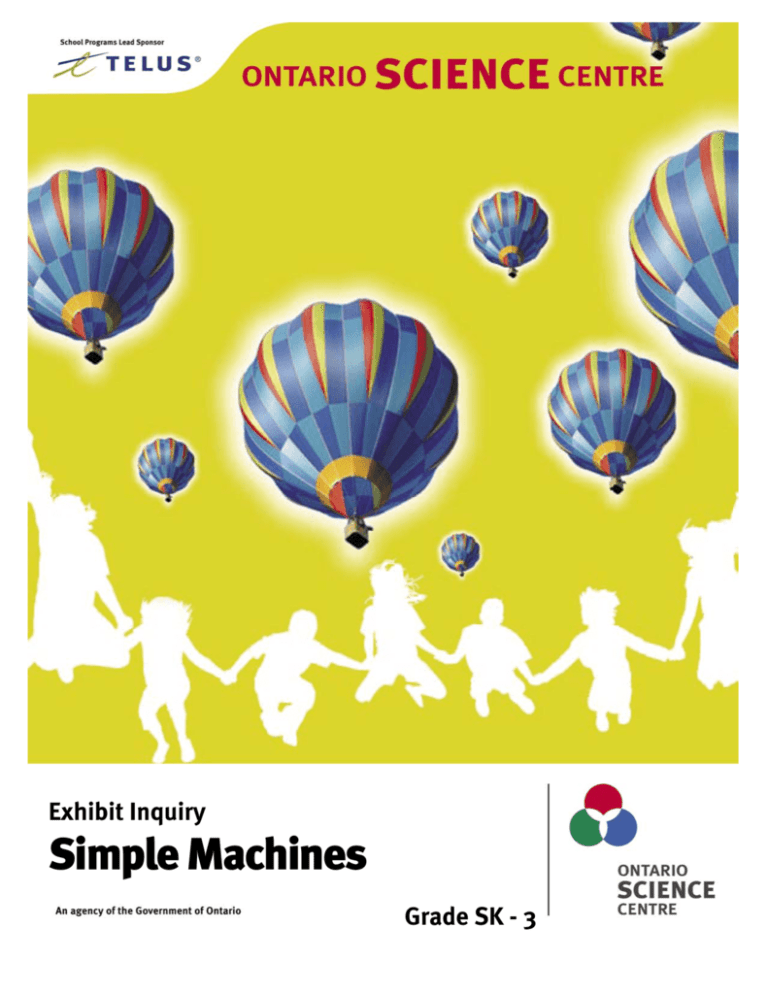
Exhibit Inquiry Simple Machines Grade SK - 3 Exhibit Inquiry Simple Machines Have students look for the following exhibits related to structures and mechanisms during their visit to the Ontario Science Centre: Art and Simple Machines Meet Where to go: What it's about: KidSpark Entrance (Level 4) Have the class individually (or in groups) study the workings of the George Rhoads sculpture. The Rhoads sculpture uses forces, motion, and the laws of physics in a pleasing and entertaining way. Keep the Ball Rolling (The Rhoads Sculpture) What to say and do: Identify the simple machines used in the workings of this exhibit (Inclined planes, levers, pulleys and gears.) The sculpture has six ball entrance points. Count the number of levers, pulleys and inclined planes at each entrance point from the time the ball enters until it returns. Inclined Planes Where to go: KidSpark (Level 4) Examples of inclined planes can be found all over KidSpark. Students can explore and expand their understanding of the inclined plane by looking for modified examples in this exhibition area. What to say and do: What are some examples of inclined planes in this area? (e.g. Coasters, Ball Fall Wall.) Explain to the students that inclined planes can be modified or changed depending on the work that needs to be done. For example, stairs have steps instead of a flat plane; in a screw, the plane wraps around the centre in a spiral. What are some examples of modified inclined planes in KidSpark? (e.g. stairs in the Two-Storey House, the water column in the Water Table.) How are these inclined planes modified? In each case, why wouldn’t a traditional inclined plane work? Aug 2011 Build Your Own Coaster Where to go: KidSpark (Level 4) Build a Coaster Roller coasters are an example of stored up potential energy – and a fun demonstration of kinetic energy when it is released! Once the “coaster” is lifted to the starting point of the ride, no other energy is put into the system potential and kinetic energy take care of the rest. What to say and do: Build a coaster track and start a ball rolling from one end – watch and remember how far it travels. Try starting the ball at different points on the track – where do you have to place it to make it go the farthest? Why does it travel farther? (It travels farther when it starts at higher points on the track.) Where does the ball have the most energy? (At the highest point.) Can you re-design and re-build the track so that the ball will travel even farther? What elements do you need to change? If you start two balls at either end of the track, where do you predict they will meet? Try it and see. Can you find where you need to start the two balls so that they meet in the middle of the track? Simple Machines at Work Where to go: What it's about: Entrance (Level 2) The elevator and escalator located at the front entrance by the Shoppers Drug Mart ® Omnimax® Theatre have clear sides allowing students to see all the simple machines at work. What to say: Identify all the simple machines you can see in the elevator and escalator. Watch the elevator and escalator to see how they work. Where is the load for each? (Elevator: inside the elevator car; Escalator: on the steps.) Resources Vocabulary Simple Machines Effort Input force applied to a simple machine that produces an output force on the load. Force Push or a pull by one body on another; these forces can change the speed or direction of an object. Fulcrum The pivot about which a lever turns. Gear A toothed wheel that engages another toothed mechanism in order to change the speed or direction of transmitted motion. Inclined plane A ramp that reduces the force necessary to lift a weight. Lever Rigid bar that pivots about a point (fulcrum) and is used to move or lift a load at one end by applying force to the other end. Load Force and weight on structure. Pulley A simple machine consisting of a wheel with a groove in which a rope can run. Screw Inclined plane threaded spirally around a cylinder. Simple machine Device that only requires the application of a single force to work. Wedge Any shape that is triangular in cross section and is usable as an inclined plane that can be pushed between two things. Classes of Levers First Class e.g., seesaw, scissors, crowbar, pliers, tin snips, hair clip, cloth pin, balance scale Second Class e.g., wheelbarrow, nutcracker, bellows, wheelbarrow, bottle opener, hole puncher, light switch, brakes, gearshift, bicycle pedal Third Class e.g., fire truck ladder, tweezers, ice cube tongs, shovel, baseball bat, tennis racket, hockey stick, golf club, stapler, fishing rod, forearm, jaw, hammer Internet Links http://www.mikids.com/Smachines.htm Books Harrison, Patricia and Ryan, Chris. Technology in Action. London: Folens Publishing, 1991. Macauley, David. The Way Things Work. Boston: Houghton-Mifflin, 1988. PLEASE NOTE: Programs and exhibits are subject to change without notice.

